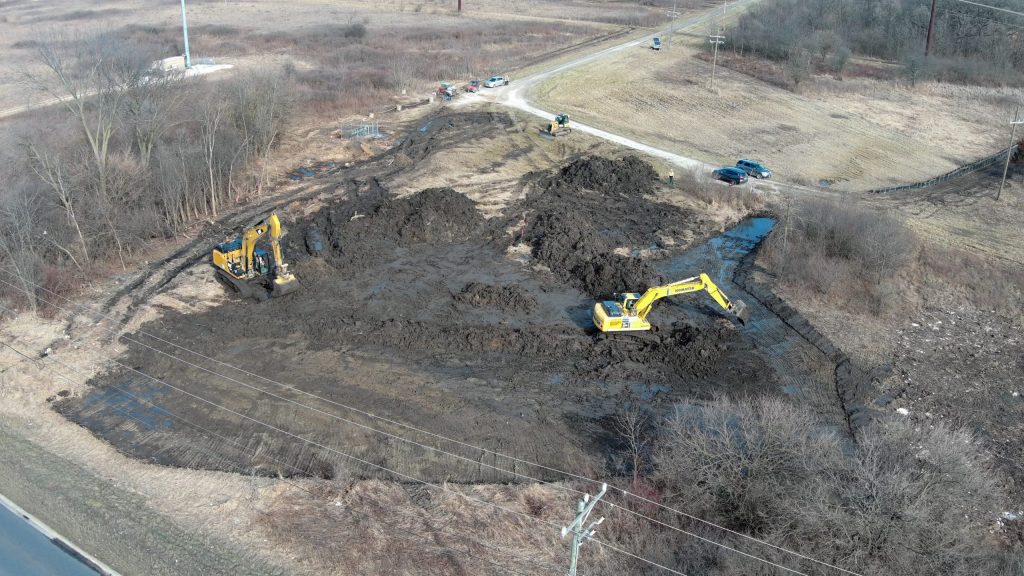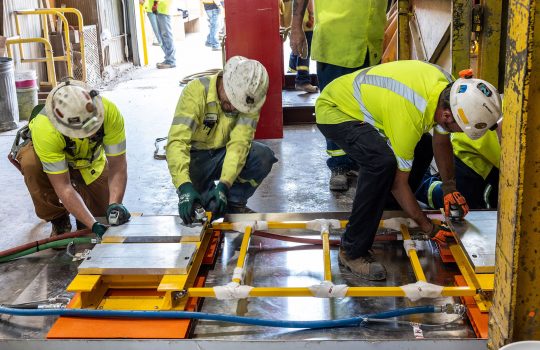As workers were completing excavation on the colossal caverns in South Dakota for the Deep Underground Neutrino Experiment, crews 800 miles away at the U.S. Department of Energy’s Fermi National Accelerator Laboratory’s Batavia campus were moving forward with the final phase of site preparation work for construction of the project’s near site facilities.
Over the winter, a team of workers removed trees and shrubs, began earthwork to prepare an area on the Fermilab site for future construction. The work covered an area of about eight acres.
This space will house the Illinois portion of the Long-Baseline Neutrino Facility, future home of the DUNE near detector and the beamline that will provide neutrinos for the experiment. LBNF/DUNE is an international collaborative partnership involving more than 200 institutions — including the European Organization for Nuclear Research — in over 35 countries. The experiment will enable scientists to further understand the role ghostly neutrino particles play in the universe.
“We are in the final stages of the site preparation phase,” said Thomas Hamernik, LBNF/DUNE-US near site conventional facilities project manager. “We are looking forward to beginning the construction of the new facility. The site preparation work sets the stage for everything else.”

Crews perform earthwork at Fermilab’s Batavia campus for the upcoming DUNE near site construction. Photo: Ryan Postel, Fermilab
Ron Ray, interim project director of LBNF/DUNE-US, emphasized the importance of the prep work being completed at the near site. “There’s some pretty amazing work that is being done for DUNE in South Dakota, and real progress is happening right here in Batavia as well,” Ray said.
“DUNE is the largest physics experiment hosted by the DOE in the United States, and the work being done here at Fermilab is getting us closer to learning more about the universe and how it works,” Ray added.
An enormous task
Fermilab’s Batavia campus will serve as the starting point for the powerful beamline that will send neutrinos from Illinois all the way to gigantic particle detectors in Lead, South Dakota at the Sanford Underground Research Facility. Located nearly a mile underground, these detectors will provide valuable data to DUNE researchers regarding the behavior of neutrinos.
The near detector in Batavia will be located approximately 60 meters (200 feet) underground and will give researchers a glimpse at the neutrino beam immediately after its creation at Fermilab. These measurements will then be compared with measurements taken at the far detector site in South Dakota.
“I’m excited to be a part of this project,” Hamernik said. “The work to come with the actual construction and then operation of the near site is going to be truly thrilling stuff. We’re on the cusp of something really big.”
The birds and the bees
Special considerations were taken regarding the timing for the site prep work. Hamernik and John Szott, LBNF/DUNE-US near site conventional facilities construction manager, worked closely with Fermilab ecologist Walter Levernier to minimize impact to the surrounding prairie habitat.
“We want to be good stewards to the land that surrounds Fermilab,” Szott said. “We made a commitment to manage our land responsibly.”
Clearing trees and shrubs in the winter months allows work to proceed without affecting nesting periods for birds and roosting periods for bats. Moving earth in the winter also avoids disrupting the bee foraging season, when plants bloom, and bees – including the threatened-and-endangered rusty patched bumblebees that inhabit tallgrass prairies of the Upper Midwest – begin their quest to find precious nectar and pollen.
“Once we clear the land needed for the next phase, we will continue to mitigate disturbances to these important habitats during construction,” Hamernik said. “The goal is to be the best long-term stewards we can, and that means managing the land to avoid future impact in the years to come.”
Being a good neighbor
Maintaining Fermilab’s good relationships with Batavia neighbors during the site preparation work was also a priority for lab management. Laboratory leadership described the work being planned to the Fermilab Community Advisory Board in July 2023. In November of 2023, Fermilab sent letters to nearby residents informing them of the upcoming work, and leadership also appeared before the Batavia City Council to present plans for the near site work.
“We want to be a good neighbor. We try to keep the surrounding residents informed so there aren’t surprises,” Hamernik emphasized. “We will monitor sound, vibration and light throughout construction.”
To minimize impact of construction noise and light on nearby residents, work is planned to only occur on weekdays, and only during normal business hours except in special circumstances.
Construction traffic during the current work period was estimated at five to 10 trucks, personal vehicles and fuel trucks in and out of the work site each day. At the completion of the work, traffic will also include 10 to 15 tractor trailers in and out of the site to remove heavy equipment and debris.
Excitement for Fermilab’s work isn’t limited to the international scientific community. Batavia Mayor Jeff Schielke recounted his decades-long appreciation for Fermilab during his remarks at the November council meeting. “I’m very pleased that this is happening,” Schielke said, noting that mayors from other communities have told him that Batavia “could become one of the most famous spots in the world” due to the research being conducted at Fermilab.
“Fermilab has turned into one of the greatest neighbors we could ever ask for,” Schielke said.
Fermi National Accelerator Laboratory is supported by the Office of Science of the U.S. Department of Energy. The Office of Science is the single largest supporter of basic research in the physical sciences in the United States and is working to address some of the most pressing challenges of our time. For more information, please visit science.energy.gov.



